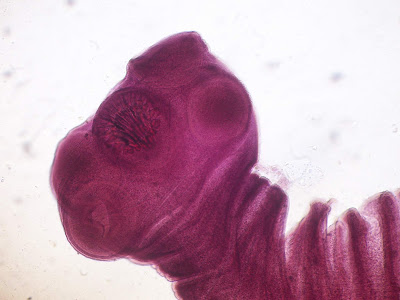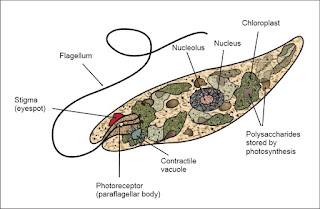Life cycle and pathogenicity of Entamoeba histolytica
Entamoeba histolytica
Classification-
Phylum — Protozoa
Subphylum – Plasmodroma
Class – Rhizopoda
Sub order – Nuda (Amoebina)
Genus – Entamoeba
Species — histolytica
Entamoeba histolytica is a protozoan endoparasite that inhabits the mucosa and submucosa layers of the human large intestine causing,dysentery and hepatic abscess.
E. histolytica is cosmopolitan in distribution, but is more common in tropical and sub-tropical countries. In India it occasionally takes an epidemic form. It is estimated that about seven to eleven per cent of the population in India suffers from its infection
Life cycle of Entamoeba histolytica
E. Histolytica is a monogenetic parasite, as it completes its life cycle in a single host, i.e., man. In its life-cycle there are three distinct morphological forms. –Trophozoite, phase Pre-cystic and phase Cystic
Trophozoite-
This is the parasite's period of development or feeding. During this time the parasite lives in the layers of mucosa and submucosa of man's large intestine.Trophozoites are unicellular organisms, with a size ranging from 18 to 40 mm in diameter (average being 20 to 30 um) During the optimal living condition the parasite exhibit slow gliding movement by forming pseudopodia, hence the body shape is not fixed because of constantly changing position .
The cytoplasm inside the body of trophozoite is divisible into clear, transparent ectoplasm and inner granular endoplasm. The endoplasm contains nucleus, ingested red blood cells and tissue debris. A single spherical nucleus lies inside the endoplasm.
The size of the nucleus ranges from 4 to 6 um. Nucleus contains a central dot like Karyosome and a delicate single layered nuclear membrane containing fine chromatin granules. The space between Karyosome and the nuclear membrane is traversed by radially arranged fine threads of limn network.
Trophozoite is a proteolytic ferment that secretes around itself. This ferment is of the histolysin type which causes destruction and necrosis of the surrounding host tissues to be ingested as food by the parasite later. Trophozoite reproduces by binary fission, and their number increases. We are primarily parasitic in nature, growing and rapidly multiplying at the cost of living tissues and multiplying rapidly to maintain their presence in good number.
Pre- Cystic stage:
It is an intermediate stage between the cystic and Trophozoite types. The parasite decreases in size (10— 20 um) during this stage, becomes avoidable in shape and bears a single blunt pseudopodia. The endoplasm contains no ingested R.B.C's and other tissue debris, meaning that the parasite stops feeding during this stage. A single nucleus remains.
Cystic stage:
The cyst development takes place inside the intestine of the host's lumen. The precystic worm travels into the gut lumen to become cystic, a process called encystations. The parasite is round during the encystation cycle, and is surrounded by a double refractile wall, called the cyst wall.
A cyst in the beginning is uninucleate body with size ranging from 7—15 um, in different races. I he nucleus inside the cyst soon divides by binary fission to become a binucleate form and then to quadrinucleate form. In this way, a single nucleus by mitotic division forms four daughter nuclei, undergoes reduction in size and ultimately becomes 2 in diameter.
Inside the cytoplasm of the cyst develops certain extra nuclear bodies like chromatid bars and glycogen mass. Chromatid bars or chromatoids are dark oblong bar like structures varying in size and number (1 to 4). In addition to chromatid bars the cyst also contains mass of glycogen in the form of brown vacuolar structure.
As the cyst transform from uninucleate to quadrinucleate stage, both chromatid bars and glycogen vacuole reduces in size and finally disappear. The whole process of encystation occurs within a few hours. The life of a matured cyst (quadrinucleate form) inside the lumen of the host’s gut is only two days.
The mature quadrinucleate cysts pass out of their host’s body through faeces. Outside the body of the host, the cyst survives for ten days and their thermal death point is about 50°c.
Mode of infection:
A matured quadrinucleate cyst of Entamoeba histolytica is the infective stage of the parasite. Transmission of E. histolytica from one person to another occurs due to ingestion of these cysts. Faecal contamination of edible substances and drinking water are the primary cause of infection. Following are the mode of transmission of this parasite-
(a) Faecal-oral route:
In majority of cases infection takes place through intake of contaminated uncooked vegetables and fruits. Insect vectors like flies, cockroaches and rodents act as agent to carry infective cysts to the food and drink. Sometimes drinking water supply contaminated with infected faces give rise to epidemics.
(b) Oral-rectal contact:
Sexual transmission by oral-rectal contact is also one of the modes of transmission, especially among male homosexuals.
Excystment-
When the quadrinucleate cyst enters in the ileum of the small intestine of the new host, the process of excystation begins. Excystation is the process of transformation of cysts to the trophozoites. It occurs in the intestinal lumen of the host. The cyst wall gets dissolved bythe neutral or alkaline intestinal juice. The nucleus inside the cyst divides once again to form eight daughter nuclei.
Certain amount of cytoplasm surrounds each of the nuclei to form 8 trophozoites The parasite at this stage moves into the caecum of the host s large intestine, get attached to the epithelial cells of the large intestine, produces necrosis by proteolytic ferment (cytolysin) and enters into the mucosa and sub-mucosa layers by means of their own mobility action.
Pathology-
The incubation period in humans varies greatly depending on the resistance of the host to the parasite. It is usually four to five days, i.e. the symptoms of the disease appear 4 to 5 days after the host is infected with the parasite.
Pathological conditions arising from E infection. Histolytica is like "amoebiasis." WHO has defined the term "amoebiasis" as the condition of the port of protozoan parasite E. Histolytica with or without clinical manifestations. However, only 10% of infected individuals have symptoms of the disease,however, appear in only 10 per cent of the infected individuals.





Comments
Post a Comment